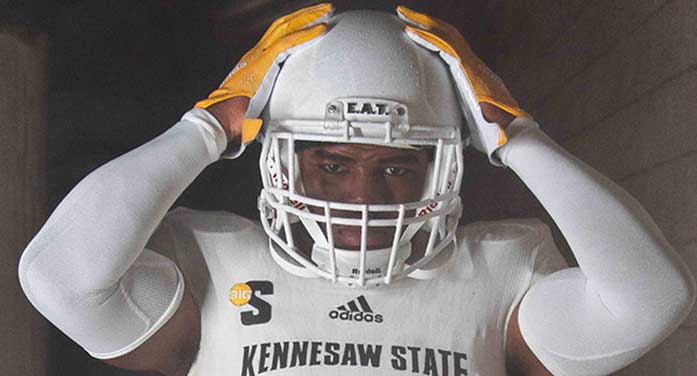 We found out recently that a bright young man with a big heart and promising future died because of football.
We found out recently that a bright young man with a big heart and promising future died because of football.
Twelve-year National Football League veteran and three-time pro bowler Vincent Jackson, who died at age 38 in February, had stage 2 CTE (chronic traumatic encephalopathy) his family announced on Thursday.
CTE is a degenerative brain disease caused by a history of multiple concussions and/or repetitive blows to the head – as is often the case in heavy contact sports like football and hockey. Stage 2 CTE is associated with behavioural symptoms such as violent aggression, impulsivity, depression, paranoia and suicidal ideation.
Life is dangerous. And there are many dangerous professions. But when it comes to brain health, pro football has to be near the top.
“Vincent Jackson was a brilliant, disciplined, gentle giant whose life began to change in his mid-30s,” said Dr. Ann McKee, chief of neuropathology for the VA Boston Healthcare System and director of the BU CTE Center and VA-BU-CLF Brain Bank. “He became depressed, with progressive memory loss, problem-solving difficulties, paranoia, and eventually extreme social isolation.
“That his brain showed stage 2 CTE should no longer surprise us; these results have become commonplace,” said McKee. “What is surprising is that so many football players have died with CTE and so little is being done to make football, at all levels, safer by limiting the number of repetitive subconcussive hits. CTE will not disappear by ignoring it; we need to actively address the risk that football poses to brain health and to support the players who are struggling.”
When Jackson turned 18 and embarked on his college football career, the dangers of CTE weren’t widely known. Today, that’s not the case. The negative impact concussions and repetitive brain trauma can have (including CTE) is widely known. Most college and pro football players understand, at least to some degree, the brain health risks that come with playing football. Undoubtedly, they – and their loved ones – should be educated more on the risks of playing football. But the vast majority of college and pro football players are over 18-years-old and free to decide.
My biggest concern is youth and high school football players who haven’t reached the age of consent and whose brains are still developing. In these cases, the adults in their lives – parents and coaches – are making the final decision as to whether or not a kid should play football.
Dr. Bennet Omalu is the forensic neuropathologist who brought CTE, its potentially dire consequences, and the dangers of playing football to the public’s attention. He’s played by Will Smith in the movie Concussion.
“We should at least wait for our children to grow up, be provided with the information and education on the risk of play, and let them make their own decisions,” wrote Omalu in a New York Times opinion piece. “No adult, not a parent or a coach, should be allowed to make this potentially life-altering decision for a child.
“We have a legal age for drinking alcohol; for joining the military; for voting; for smoking; for driving; and for consenting to have sex,” wrote Omalu. “We must have the same when it comes to protecting the organ that defines who we are as human beings.”
It’s hard to argue with that.
 The challenge – and it’s a huge one – is that American society loves football so much that it’s easy to avoid hard discussions about the sport’s safety. It’s a fun and entertaining sport, no doubt. But we must look at it head on with clear eyes. Broken arms, torn knee ligaments and dislocated shoulders are one thing. Serious damage to the brain, the organ that gives humans their personalities and ability to function effectively, is quite another.
The challenge – and it’s a huge one – is that American society loves football so much that it’s easy to avoid hard discussions about the sport’s safety. It’s a fun and entertaining sport, no doubt. But we must look at it head on with clear eyes. Broken arms, torn knee ligaments and dislocated shoulders are one thing. Serious damage to the brain, the organ that gives humans their personalities and ability to function effectively, is quite another.
An eye-opening study done by researchers at the Boston University CTE Center shows that each year a person endures repetitive head collisions in football, the risk of developing CTE increases by 30 percent. In addition, for every 2.6 years of play, the risk of developing CTE doubles.
It’s not realistic to think football will ever be banned in the United States. However, we need to do all we can to limit contact to the head in the sport. Some steps have been taken in this direction, but more needs to be done. Some possibilities presented by various parties include eliminating full-contact practices, no tackling or blocking that leads with the head instead of shoulders and arms, requiring all linemen to be in two-point stances, and severe penalties for spearing.
If these actions – or others with a similar intent – aren’t implemented, we’ll continue to regularly read sad stories like that of Jackson and former NFL player Philip Adams. The same week the news about Jackson broke we learned that Adams had stage 2 CTE when he shot and killed six people before taking his own life in April in South Carolina.
It’s all just so sad.
Ken Reed is sports policy director for League of Fans (leagueoffans.org), a sports reform project. He is the author of The Sports Reformers, Ego vs. Soul in Sports, and How We Can Save Sports. For interview requests, click here.
The opinions expressed by our columnists and contributors are theirs alone and do not inherently or expressly reflect the views of our publication.
© Troy Media
Troy Media is an editorial content provider to media outlets and its own hosted community news outlets across Canada.


